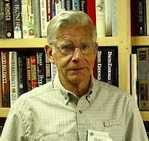
It's a cold, breezy November view from the Meeting House deck. The once red and gold hills against an azure sky are now starkly sullen, portending a time of gray and white. But this is just a beginning: a cleaning of the artist's palette, a clearing of the actors' set. Spring will eventually, eagerly, fill the canvas and re-set the stage.
But let's leave the deck and walk a little before the sun sinks lower and the chill sets in.
Our steps on this old logging road crunch the leaves that no longer block our view of the telltale branching patterns of the trees. There are the wispy elms, the oaks’ blunt twigs - some with maturing acorns -- the basswood buds that resemble hanging drops of rain, and the ash "chopstick" branches reaching skyward. If we look carefully, we see that each species is different, each bark color, texture and pattern unique. Even in winter, there's a lot going on here: the trees are growing, albeit a lot slower.
See those holes in larger branches? Some show worn edges from seasons of ins and outs and may still have screech owl or flying squirrel as tenants. Here's a sugar maple with a tan pad of hundreds of over-wintering gypsy moth eggs and another with woodpecker search holes. Those lower branches in that patch of young hemlocks will provide heat-reflecting shelter to birds and animals in mid-winter.
Why all this looking and pointing out? Well, I suppose it's just force of habit. As a forester, I work with property owners who have a variety of reasons for owning and using their woods. I need to know not only what trees are present but also how fast they grow. I also need to be aware of the dynamics of each forest. All this in order to help landowners achieve their goals for their woods.
Of course, many times, one goal is to procure income. The short-term question is, are there enough trees of sufficient value to support a cutting without destroying the integrity or viability of the woods? Then we step back and consider the long-range goals of woodland ownership. Is there an immediate need for income? to pay the mortgage? send a child to college? take a trip? replace that pickup truck? Your trees, I tell the landowner, are a bank account, their growth the interest.
On the other hand, if the woodlot will remain in the family, how can one remove some trees now and save others for the next generation? Selecting trees to log includes removing those that are mature, or are slow growing, or have disease or insect problems. At the same time, it is important to retain those trees that are genetically able to resist pest attacks and grow to a valuable maturity.
There are marking rules, stocking tables, growth charts, maps, and research papers to assist the forester's judgment in managing woods. And the forester needs to understand the history of the particular woods, its soils and its topography, the wildlife, ponds, and streams - and how it all fits together. Nature is complex.
My feet are cold. Snow may be approaching. Let's head back to the Meeting House. But let's consider forests in these words from Malcolm Forbes:
"Trees are life. Without them it's hard to imagine that there could be lives. Essential as they are for our existence, they are even more consequential to our spirits, which grow and soar and green and change as they do."
Ken Hotopp, retired Cornell Cooperative extension agent and former forester for NYS-DEC, is a consulting certified forester who specializes in private and municipal woodland management. He and his wife Marian are long-time Arboretum members and volunteers. Having managed the Arboretum's bookshop for many years, they are affectionately known as "the Bookies."
